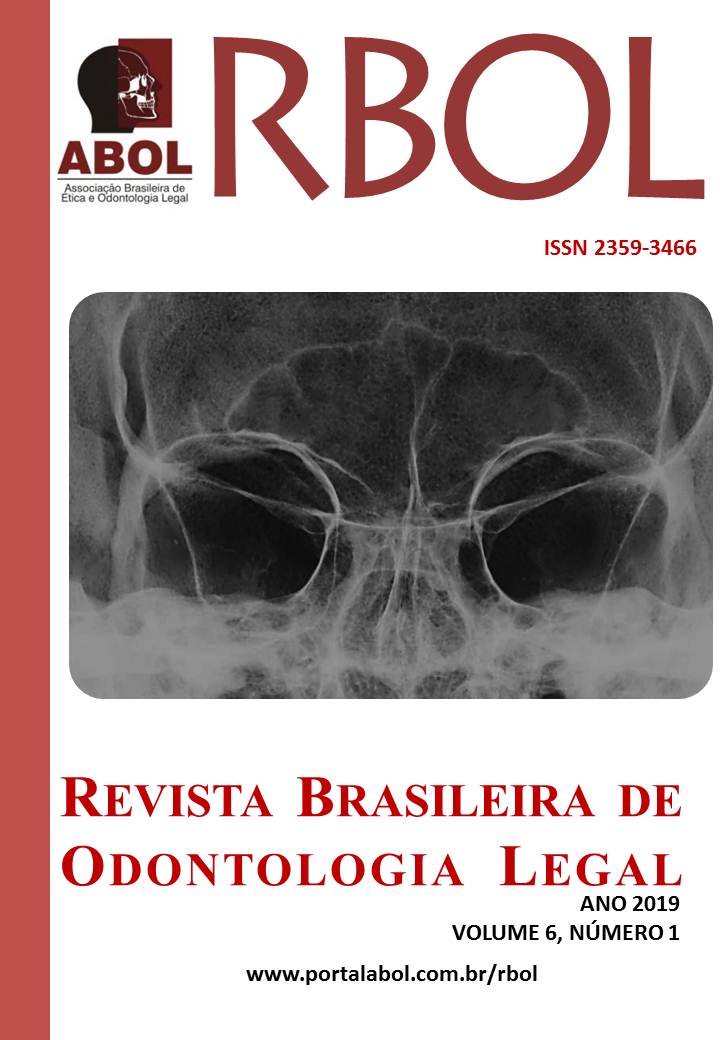CAN DENTAL ANESTHESIA LEAD TO DEATH? CRIME INVESTIGATION REPORT
DOI:
https://doi.org/10.21117/rbol.v6i1.227Palavras-chave:
Forensic Dentistry, Anesthesia, Dental, Death, Sudden, Tooth Extraction, EmergenciesResumo
Emergency situations that may lead to the death of an individual, even when there is no cause directly related to the treatment, occur with certain frequency in dental offices. The purpose of this study was to report a case that involved an inquiry and police investigation related to the death of a female patient after the injection of two ampoules of 2% lidocaine anesthetic for dental treatment. The patient died despite assistance given by the professional and by SAMU (Urgent Mobile Medical Service). The legal authorities inquired into the possibility that the amount of anesthetic may have caused the patient’s death. However, it was proven that the amount of anesthesia was adequate, and the recommendation of the Public Prosecutor's Office was for closure of the case because of lack of evidence justifying occurrence of the crimeReferências
Müller M, Hänsel M, Stehr S, Weber S, Koch T. A state-wide survey of medical emergency management in dental practices: incidence of emergencies and training experience. Emerg Med J. 2008; 25(5):296-300. http://dx.doi.org/10.1136/emj.2007.052936.
Atherton G, McCaul J, Williams S. Medical emergencies: Medical emergencies in general dental practice in Great Britain Part 1: their prevalence over a 10-year period. Brit Dent J. 1999; 186(2):72-9.
Silva, EF, Barbosa FC, Valença KS, Picoli FF, Rodrigues LG, Souza JB, et al. O impacto das reportagens divulgadas na internet relacionadas a casos de morte decorrentes de tratamento odontológico. ROBRAC. 2016;25(72):49-53.
Tomlin PJ. Death in outpatient dental anaesthetic practice. Anaesthesia. 1974;29:551-70.
Jastak JT, Peskin RM. Major morbidity or mortality from office anesthetic procedures: a closed-claim analysis of 13 cases. Anesth Prog. 1991;38(2):39-44.
McCarthy FM. Sudden, unexpected death in the dental office. J Am Dent Ass. 1971;83(5):1091-2.
Brasil. Código Penal. Decreto-lei 2.848, de 7 de dezembro de 1940. Disponível em: http://www.planalto.gov.br/ccivil_03/decreto-lei/Del2848compilado.htm.
Malamed SF. Local anesthetics: dentistry’s most important drugs, clinical update 2006. J Calif Dent Assoc. 2006;34(12):971-6.
Tong HJ, Alzahrani FS, Sim YF, Tahmassebi JF, Duggal M. Anaesthetic efficacy of articaine versus lidocaine in children's dentistry: a systematic review and meta‐analysis. Int J Paediatr Dent. Epub 2018 Apr 10.
Berkun Y, Ben-Zvi A, Levy Y, Galili D, Shalit M. Evaluation of adverse reactions to local anesthetics: experience with 236 patients. Ann Allergy Asthma Immunol. 2003;91(4),342-5.
Batinac T, Sotošek Tokmadžić V, Peharda V, Brajac I. Adverse reactions and alleged allergy to local anesthetics: analysis of 331 patients. J Dermatol. 2013;40(7):522-7.
Haas DA. An update on local anesthetics in dentistry. J Can Dent Assoc. 2002;68(9):546-52.
Ogle OE, Mahjoubi, G. Local anesthesia: agents, techniques, and complications. Dent Clin North Am. 2012;56(1);133-48. https://doi.org/10.1016/j.cden.2011.08.003.
Baluga J, Casamayou R, Carozzi E, et al. Allergy to local anaesthetics in dentistry. Myth or reality? Allergol Immunopathol. 2012;30(1):14-9.
Malamed SF. What's new in local anesthesia? Anesth Prog. 1992;39,125-31.
Malamed SF. Handbook of local anesthesia. Saint Louis: Elsevier Health Sciences; 2014.
Malamed SF. Local anesthetics: dentistry’s most important drugs, clinical update 2006. J Calif Dent Assoc. 2006;34(12):971-6.
Silva RF, do Prado MM, Rodrigues LG, Picoli FF, Franco, A. Importância ético-legal e significado das assinaturas do paciente no prontuário odontológico. Rev Bras Leg Odontol - RBOL. 2016;3(1): 70-83. http://dx.doi.org/10.21117/rbol.v3i1.49.
Ferraz, EG, Carvalho, CM, Jesuíno, AA, Provedel, L, Sarmento, VA. Avaliação da variação da pressão arterial durante o procedimento cirúrgico odontológico. Rev Odontol UNESP. 2007;36(3):223-9.
Loffredo, LDCM, Telarolli Jr R, Basso MFM. Prevalência de hipertensão arterial sistêmica em estudantes da faculdade de Odontologia de Araraquara–Unesp. Rev Odontol UNESP. 2003; 32(2): 99-104.
Conselho Nacional de Justiça. Justiça em números - Ano-base 2013, CNJ, Brasília, 2014.
Wanderley RB, Moreira VG, Cardoso AMR, Nunes FMR, Rabello PM, Santiago BM. Levantamento das Jurisprudências de Processos de Responsabilidade Civil Contra Cirurgiões-Dentistas nos Tribunais de Justiça Brasileiros. Rev. Brasil Ciências Saúde. 2012;16(1):49-58. https://doi.org/10.4034/rbcs.2012.16.01.08.
de Paula FJ, Muñoz DR, da Silva M, da Motta MV. Reclamações fundamentadas sobre o tratamento dentário no Procon da cidade de São Paulo (2006-2010). Rev. Assoc. Paul. Cir. Dent. 2013; 67(1):56-63.
Mazzilli HN. O acesso à justiça e o Ministério Público. São Paulo: Saraiva; 2007.
Brasil. Constituição da República Federativa do Brasil. Brasília, Centro Gráfico do Senado Federal; 1988.
Downloads
Publicado
Edição
Seção
Licença
Os autores deverão encaminhar por email, devidamente assinada pelos autores ou pelo autor responsável pelo trabalho, a declaração de responsabilidade e transferência de direitos autorais para a RBOL, conforme modelo abaixo.
DECLARAÇÃO DE RESPONSABILIDADE E TRANSFERÊNCIA DE DIREITOS AUTORAIS
Eu (Nós), listar os nomes completos dos autores, transfiro(rimos) todos os direitos autorais do artigo intitulado: colocar o título à Revista Brasileira de Odontologia Legal - RBOL.
Declaro(amos) que o trabalho mencionado é original, não é resultante de plágio, que não foi publicado e não está sendo considerado para publicação em outra revista, quer seja no formato impresso ou no eletrônico.
Declaro(amos) que o presente trabalho não apresenta conflitos de interesse pessoais, empresariais ou governamentais que poderiam comprometer a obtenção e divulgação dos resultados bem como a discussão e conclusão do estudo.
Declaro(amos) que o presente trabalho foi totalmente custeado por seus autores. Em caso de financiamento, identificar qual a empresa, governo ou agência financiadora.
Local, data, mês e ano.
Nome e assinatura do autor responsável (ou de todos os autores).

